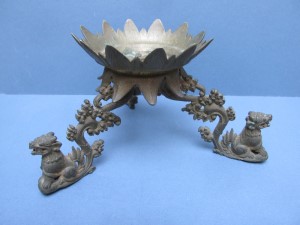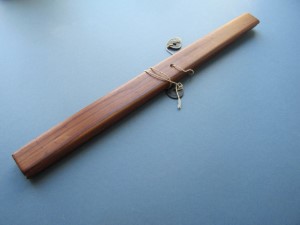|
New
|

Very rare object, used during holy water rituals on Bali. The Hindu priest will create holy water by handgestures (mudra's) and uttering texts (mantra's). The container with holy water is placed on the tripada.
Please click on the photo for more photos-info.
1850-1900
|
|
tripada
|
|
|
New
|

Small but delicate woodcarving done by Balinese master Ida Bagus Tantra.
1950-1960
According to Bali expert Bruce Carpenter it was Tantra who introduced the Botero style on Bali.
Tantra was a nephew of the great Ide Bagus Njana.
Rudolf Bonnet made a portrait of him in 1974, see the last 2 photos.
If you click on the photo there is more info&photos.
|
|
Small but delicate woodcarving done by Balinese master Ida Bagus Tantra.
|
|
|
New
|

Woodcarving of a goat, made in prewar Bali by a anonymous artist.
1930-1940
|
|
Woodcarving of a goat, made in prewar Bali by a anonymous artist.
|
|
|
New
|

Woodcarving of a goat
1950-1970
Good example of small carving done by an accomplished artist. This goat was made for the tourist market; no doubt about that. And maybe he was able to finish this in a day. But still such a goat is pretty hard to create, and the result is great; full of class and humor. Maybe Ajun was enjoying himself!
|
|
Woodcarving of a goat
|
|
|
New
|

Lontar manuscript 1930-1940 from the collection of Prof C Bonne (1891-1948). Prof Bonne was professor at the Medical School in Batavia, and editor of the Medical Magazine in the Dutch Indies.
1930-1940
This remarkable lontar came from the collection of Prof C Bonne. He was an important doctor in the Dutch Indies.
The very detailed drawings depict scenes from the Ramayana acoompanied by Balinese words.
This was no touristic item, but more a show of force by an experienced (most likely) Balinese lontar writer.
Important lontars had covers made of expensive wood, and the side of leaves were painted red, like this one.
In some cases even a special box was made to preserve the lontar, like in TOBO 753 and TOBO 800.
|
|
Lontar manuscript 1930-1940 from the collection of Prof C Bonne (1891-1948). Prof Bonne was professor at the Medical School in Batavia, and editor of the Medical Magazine in the Dutch Indies.
|
|
|
New
|

Silver modesty plate or Jempang from Sulawesi, Toraja land.
Worn by young children to cover the private parts.
1910-1940
This Jempang is much bigger than the usual Jempang. See the last photo.
It raises the question whether this seize was made for somewhat older children.
|
|
Silver modesty plate or Jempang from Sulawesi, Toraja land.
Worn by young children to cover the private parts.
|
|